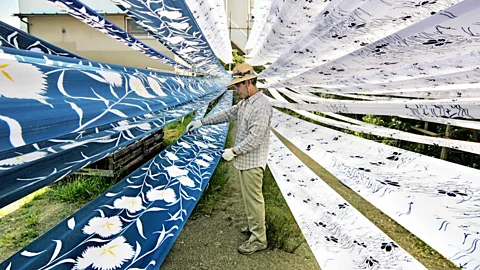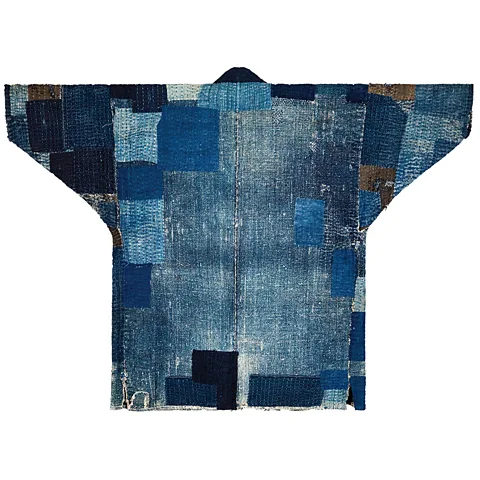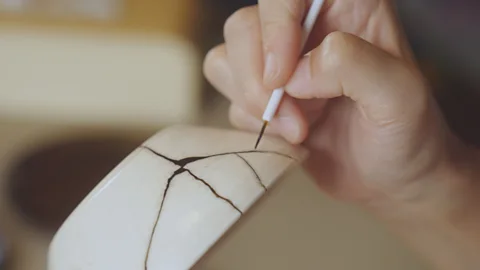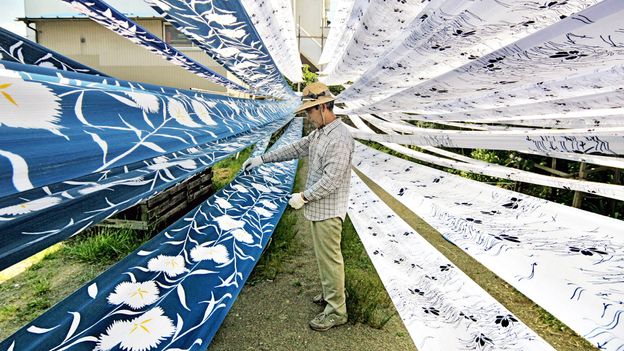 Getty Images
Getty ImagesHow a recycled garment made from tattered rags symbolises the ingenuity of what could have been one of the world’s first large-scale ecological civilisations.
Imagine standing on the old wooden Nihonbashi bridge in the commercial heartland of Edo, the ancient Japanese city now known as Tokyo. It is some time around 1750 during the Edo period, the era from 1603 to 1868 ruled by the Tokugawa shoguns.
You are surrounded by a bustle of chattering locals twirling their umbrellas, seafood traders rushing across the bridge, balancing brimming baskets on their shoulders, and labourers carrying rice and cloth to the market stalls on either side of the riverbank. The smell from the famous Nihonbashi Uogashi – the fish market – wafts through the air.
It is a huge city of nearly one million people – far bigger than London or Paris at the time. You notice that almost everything seems to be made of wood – houses, carts, the bridge itself. But what is less obvious is that you are gazing upon what may be one of the world’s first large-scale ecological civilisations.
 Alamy
AlamyAncient Japan, I argue in my new book History for Tomorrow, offers inspiration for creating the deeply sustainable society we so urgently need today. Humanity’s material footprint is almost double what the planet can safely sustain: we are using up the resources of nearly two planet Earths annually. Just think of the e-waste mountains, the biodiversity loss, the oceans polluted with microplastics, the deforestation to graze the cattle needed to feed our insatiable hunger for meat. What’s more, most of this ecological overshoot is driven by the consumers of wealthy nations. The rich are devouring the world.
Edo was different. Partly due to the government’s policy of not trading with outside nations, there was a scarcity of key resources like cotton and timber. The result was that Edo was a city without waste. Almost everything was reused, repaired, repurposed or in the last instance recycled – what we would today call a circular economy. The Edo economy “ran as a very efficient closed-loop system”, argues sustainability historian Eisuke Ishikawa.
A traditional yukata – a simple cotton summer kimono – would be used until the cloth began to wear out, at which point it had become soft enough to be turned into pyjamas. Its next stage of life was to be cut up for nappies, which could be washed again and again, after which it might become a floor cloth before finally being burned as fuel.
Cotton was so precious that a tradition of patchwork called boro – literally “tattered rags” – was developed in parts of Japan, with poor villagers collecting fragments of discarded cloth and sewing them into coats and other garments, which would be passed down from generation to generation.
 Alamy
AlamyThe city of Edo was home to over 1,000 refurbishing and recycling businesses. Everything was collected for reuse – the drippings of candle wax were remoulded, old metal pots were melted down, human hair was sold to wig makers. Modular house design meant that floorboards could easily be removed, planed down and used again in new buildings. Samurai down on their luck repaired umbrellas. The leftover straw from growing rice was used for making sandals and rope, wrapping up household goods, and finally as fertiliser and fuel.
Paper recycling was a huge industry – they even recycled used toilet paper, which was made from the tough fibres of bark. You didn’t pay nightsoil men to take away human waste – they paid you, then sold on the precious load as agricultural fertiliser.
This culture of deep sustainability was reinforced by strict regulations to deal with timber shortages. Japan’s economy was as dependent on wood as we are today on fossil fuels. When the Tokugawa shoguns took power, they were facing an acute scarcity of this essential resource: ancient woodlands had been so severely depleted – partly due to population growth – that there was a genuine threat of economic collapse.
To avoid this fate, the regime introduced bans on logging, including limits on felling trees of certain sizes and species, to allow for forest regeneration. Fines were substantial and, in some regions, breaking the rules was punishable by death. They also enforced a wide-ranging system of timber-rationing for the construction of houses and other new buildings. The rules were closely linked to status: those higher up the social hierarchy, such as samurai and lords, were permitted greater use of scarce timbers and could build larger homes – but they too faced restrictions.
 Alamy
AlamyOn top of this, the Tokugawas embarked on one of the most extensive programmes of plantation forestry the world had ever seen. Villagers were offered cash payments for planting new trees and new rules were introduced to promote rental forests, where a villager planted a site and sold the timber in advance to a merchant, and would then replant and re-lease the land several decades later when the trees had been harvested. Over a period of a century, beginning around 1750, tens of millions of trees were planted, reafforesting the denuded landscape.
This combination of sustainable circularity and resource regeneration was the essence of what has being called the “Edonomy” of preindustrial Japan. It emerged not only from resource scarcity and the Tokugawa’s desire to preserve the country for their descendants, but from the ideal of mottainai – a sufficiency principle of not being wasteful and having “just enough”.
Ancestral circular economies
The Edo period remains one of the best historical examples of what a large-scale regenerative economy operating within safe ecological limits might look like (there are others, such as the “ancestral circular economy” of precolonial Hawaii). It was, writes environmental scientist Eiichiro Ochiai, a “model for spaceship Earth” that took “every possible step to maintain the principles of zero-waste, zero-emission, long before such terms came to be appreciated”.
It is important to recognise that ancient Japan was no utopia: it was a feudal society ruled by a military dictatorship where patriarchal oppression of women was the norm. But it is equally worth noting that Edo’s low-footprint economy was sustained over nearly two centuries and produced an extraordinary era of cultural flourishing.
 Getty Images
Getty ImagesIt gave birth to the poetry of Bashō, the artworks of Hiroshige, and a thriving culture of street theatre, sumo wrestling, pottery, calligraphy and flower arranging. If you ever hear someone claiming that living ecologically will have us all eking out a rudimentary existence and dwelling in caves, just tell them about Edo.
But what would it take to create an Edo 2.0 that is fit for the ecological realities of the 21st Century? What insights might we draw from the past?
One lesson is that we could follow Edo’s lead by striving to create a no-waste circular economy. We could be “editing out” the old linear “take, make, use, lose” industrial system and replacing it with cyclical systems where materials are used again and again. The typical iPhone contains two-thirds of the elements in the periodic table and is thrown away after just four years. Instead, phones could be made from a range of sustainable models resembling the Dutch Fairphone, which uses recycled plastic and copper, and allows for every component part – from screens to batteries – to be easily repaired or replaced by the owner.
If businesses have a five-year regulatory lead time, there would be time for them to adjust to the new rules, as they are already doing in preparation for the banning of fossil fuel cars from the streets of cities like Paris. The European Union is leading the way with new “right to repair” legislation. Only 7.2% of the global economy is currently circular. If we hope to boost that to Edo levels, companies like Apple, Samsung and Tesla will need to be legally obligated to up their circular game.
A second lesson is to consider ratcheting down consumer demand to sustainable levels, especially in wealthy countries, by following the Edo example of rationing – in our case for major ecological culprits like carbon and red meat. Rationing often conjures up images of drab wartime austerity, or visions of an overbearing government taking away our freedoms – yet there is a growing global movement of policymakers and thinktanks who view rationing as a viable – even necessary – response to the global ecological emergency, as long as it done fairly and isn’t skewed to benefiting the well-off.
“Developing a system of individual carbon cards,” writes the French economist Thomas Piketty, “will certainly be part of the indispensable institutional tools for meeting the climate challenge”. Others have rebranded rationing as “personal carbon allowances“.
If the Tokugawa shoguns were around today, they might have imposed rationing as an emergency measure for a planet in peril. In this “year of elections”, with half the world’s population going to the polls, newly elected governments might be wise to look to Japanese history for inspiration and direction. In the words of the Māori proverb, Kia whakatōmuri te haere whakamua – “I walk backwards into the future with my eyes fixed on the past”.


